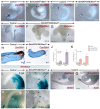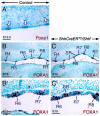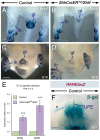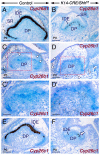Sonic Hedgehog Signaling Is Required for Cyp26 Expression during Embryonic Development
- PMID: 31072004
- PMCID: PMC6540044
- DOI: 10.3390/ijms20092275
Sonic Hedgehog Signaling Is Required for Cyp26 Expression during Embryonic Development
Abstract
Deciphering how signaling pathways interact during development is necessary for understanding the etiopathogenesis of congenital malformations and disease. In several embryonic structures, components of the Hedgehog and retinoic acid pathways, two potent players in development and disease are expressed and operate in the same or adjacent tissues and cells. Yet whether and, if so, how these pathways interact during organogenesis is, to a large extent, unclear. Using genetic and experimental approaches in the mouse, we show that during development of ontogenetically different organs, including the tail, genital tubercle, and secondary palate, Sonic hedgehog (SHH) loss-of-function causes anomalies phenocopying those induced by enhanced retinoic acid signaling and that SHH is required to prevent supraphysiological activation of retinoic signaling through maintenance and reinforcement of expression of the Cyp26 genes. Furthermore, in other tissues and organs, disruptions of the Hedgehog or the retinoic acid pathways during development generate similar phenotypes. These findings reveal that rigidly calibrated Hedgehog and retinoic acid activities are required for normal organogenesis and tissue patterning.
Keywords: CRE/LoxP; Cyp26 enzymes; congenital anomalies; hedgehog signaling; mouse models; retinoic acid; smoothened; sonic hedgehog.
Conflict of interest statement
The authors declare no conflict of interest.
Figures







Similar articles
-
Cell fate specification in the lingual epithelium is controlled by antagonistic activities of Sonic hedgehog and retinoic acid.PLoS Genet. 2017 Jul 17;13(7):e1006914. doi: 10.1371/journal.pgen.1006914. eCollection 2017 Jul. PLoS Genet. 2017. PMID: 28715412 Free PMC article.
-
Retinoic acid signaling regulates sonic hedgehog and bone morphogenetic protein signalings during genital tubercle development.Birth Defects Res B Dev Reprod Toxicol. 2012 Feb;95(1):79-88. doi: 10.1002/bdrb.20344. Epub 2011 Nov 29. Birth Defects Res B Dev Reprod Toxicol. 2012. PMID: 22127979 Free PMC article.
-
Activation of the hedgehog signaling pathway in the developing lens stimulates ectopic FoxE3 expression and disruption in fiber cell differentiation.Invest Ophthalmol Vis Sci. 2012 Jun 5;53(7):3316-30. doi: 10.1167/iovs.12-9595. Invest Ophthalmol Vis Sci. 2012. PMID: 22491411 Free PMC article.
-
Sonic hedgehog signaling in the developing CNS where it has been and where it is going.Curr Top Dev Biol. 2011;97:75-117. doi: 10.1016/B978-0-12-385975-4.00010-3. Curr Top Dev Biol. 2011. PMID: 22074603 Review.
-
Retinoic acid, CYP26, and drug resistance in the stem cell niche.Exp Hematol. 2017 Oct;54:17-25. doi: 10.1016/j.exphem.2017.07.004. Epub 2017 Jul 25. Exp Hematol. 2017. PMID: 28754309 Free PMC article. Review.
Cited by
-
RA-induced prominence-specific response resulted in distinctive regulation of Wnt and osteogenesis.Life Sci Alliance. 2023 Aug 4;6(10):e202302013. doi: 10.26508/lsa.202302013. Print 2023 Oct. Life Sci Alliance. 2023. PMID: 37541848 Free PMC article.
-
Regulating Retinoic Acid Availability during Development and Regeneration: The Role of the CYP26 Enzymes.J Dev Biol. 2020 Mar 5;8(1):6. doi: 10.3390/jdb8010006. J Dev Biol. 2020. PMID: 32151018 Free PMC article. Review.
-
Future Tail Tales: A Forward-Looking, Integrative Perspective on Tail Research.Integr Comp Biol. 2021 Sep 8;61(2):521-537. doi: 10.1093/icb/icab082. Integr Comp Biol. 2021. PMID: 33999184 Free PMC article. Review.
-
Premature Growth Plate Closure Caused by a Hedgehog Cancer Drug Is Preventable by Co-Administration of a Retinoid Antagonist in Mice.J Bone Miner Res. 2021 Jul;36(7):1387-1402. doi: 10.1002/jbmr.4291. Epub 2021 Apr 20. J Bone Miner Res. 2021. PMID: 33724538 Free PMC article.
-
Down-Regulation of Inpp5e Associated With Abnormal Ciliogenesis During Embryonic Neurodevelopment Under Inositol Deficiency.Front Neurol. 2021 May 19;12:579998. doi: 10.3389/fneur.2021.579998. eCollection 2021. Front Neurol. 2021. PMID: 34093381 Free PMC article.
References
-
- McMahon A.P., Ingham P.W., Tabin T.J. Developmental roles and clinical significance of hedgehog signaling. Curr. Top. Dev. Biol. 2003;53:1–114. - PubMed
MeSH terms
Substances
Grants and funding
LinkOut - more resources
Full Text Sources
Medical
Molecular Biology Databases

